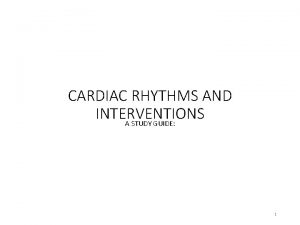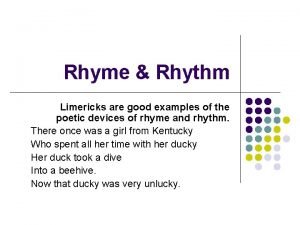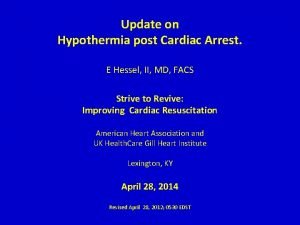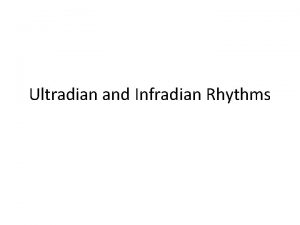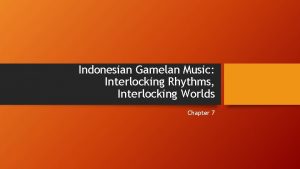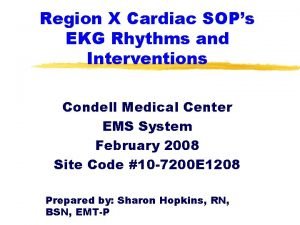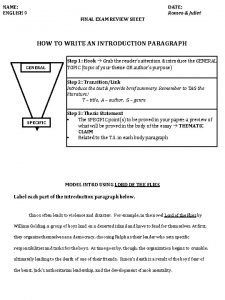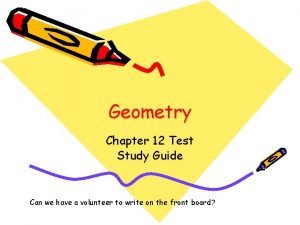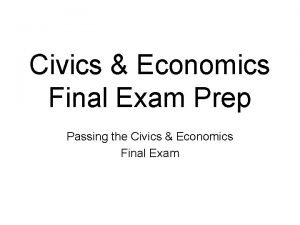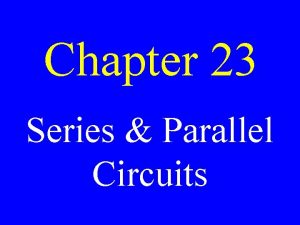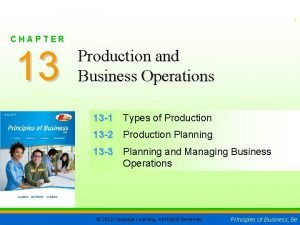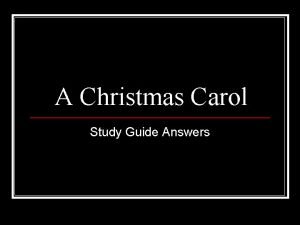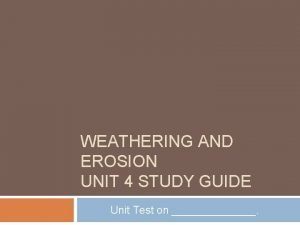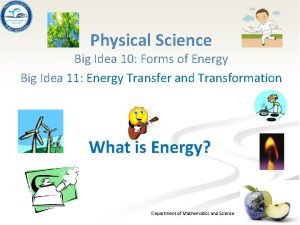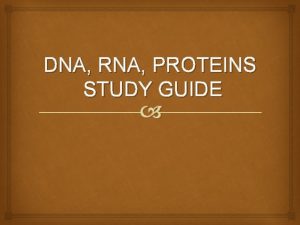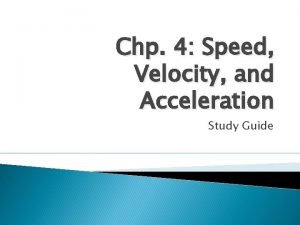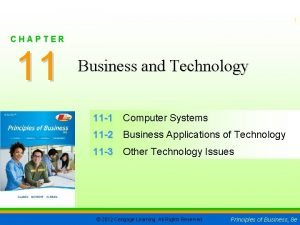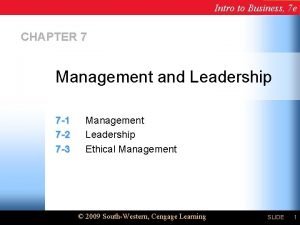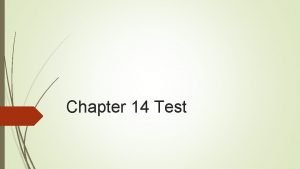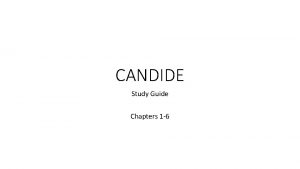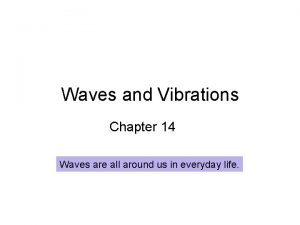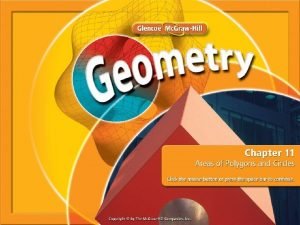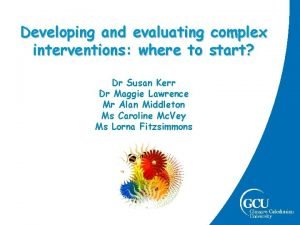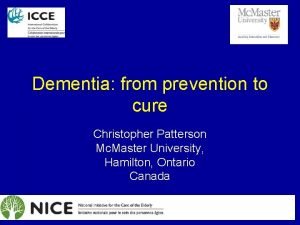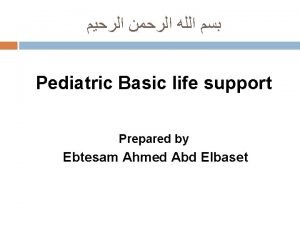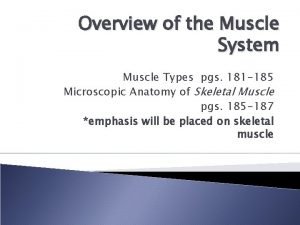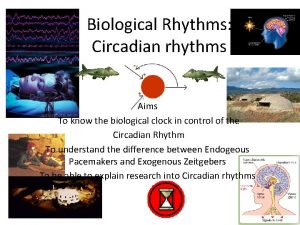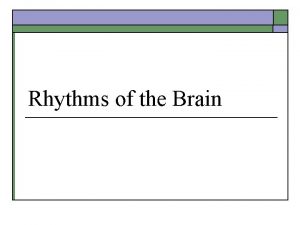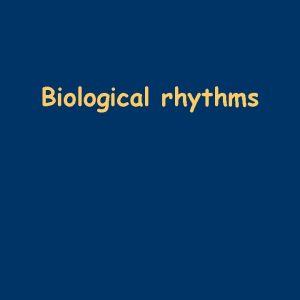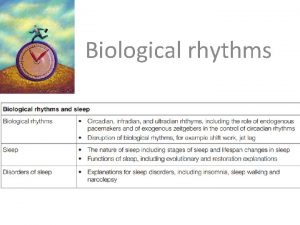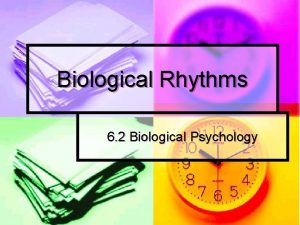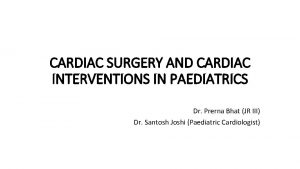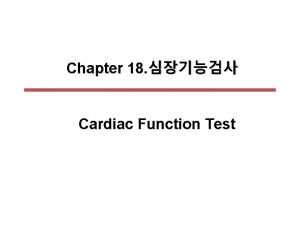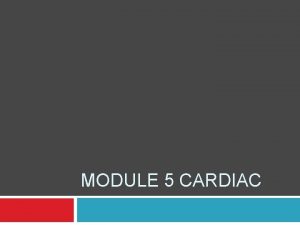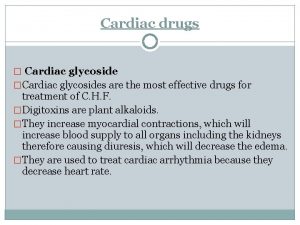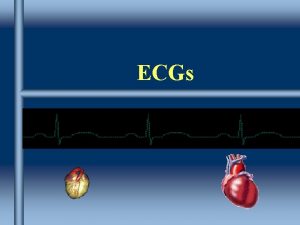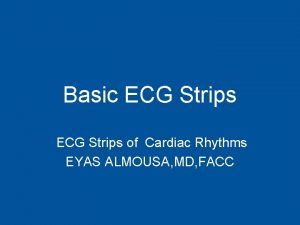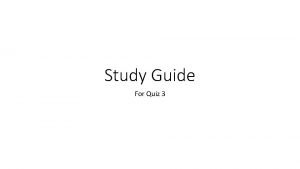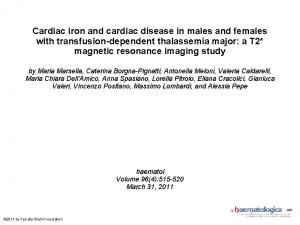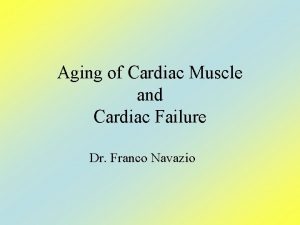CARDIAC RHYTHMS AND INTERVENTIONS A STUDY GUIDE 1















































- Slides: 47

CARDIAC RHYTHMS AND INTERVENTIONS A STUDY GUIDE: 1

STUDY GUIDE • This Study Guide is to be used as a review to prepare you for the annual EKG Competency. • This Study Guide provides the basics of EKG Interpretation and should be used to enhance your learning and prompt you to seek other resources. This Study Guide is not designed as the initial learning for EKG Interpretation. 2

THE HEART 3

4

THE CONDUCTION SYSTEM 5

SOME OF THE BASICS TO KNOW • The ability of a cell to initiate an impulse without outside stimulation is called ________. • The movement of a wave of negative charges which results in relaxation is called _______. • The mechanical events of the heart are _______and ________. • The primary pacemaker of the heart is the_____. • The rate of the AV Node is _____ • The rate of the Purkinje Fibers is: ______. Answers located on Page 41 6

REVIEW • If the SA node fails, there are 2 other pacemakers that can take over. These pacemakers are the _____ and the ______ • Arrange numerically (1 through 5) the Normal conduction system of the heart • _______Purkinje Fibers • _______SA Node • _______Bundle of His • _______AV Node • _______Right and Left Bundle Branches • Answers located on Page 42 7

BUNDLE BRANCH BLOCK 8

REVIEW • Depolarization of the atria is represented on the EKG as the ____. • Depolarization of the ventricles is represented on the EKG as the______. • A normal PR Interval measures: ________ • The QT Interval is measured from the ______to the______. • A normal QRS Interval measures: _____. Answers located on Page 43 9

CAN YOU CORRECTLY IDENTIFY THE CONDUCTION SYSTEM? 1______ 2______ 3______ 4______ 5______ 6______ 7______ 8______ Answers located on Page 10 10

CONDUCTION SYSTEM ANSWERS 1 : SA NODE 2 : LEFT ATRIUM 3 : LEFT VENTRICLE 4 : APEX 5 : PURKINJE FIBERS 6 : BUNDLE BRANCHES 7 : AV BUNDLE 8 : AV NODE 11

5 -LEAD ELECTRODE PLACEMENT Make sure your leads are in correct position, adhere securely to the skin, and not obstructed by other drains and dressings. Assure that your EKG rhythm is clear, readable, and free of 12 artifact.

CALCULATING ACCURATE HEART RATES CALCULATING A HEART RATE WITH A REGULAR RHYTHM: • Measure R to R Interval. Divide # of small boxes into 1500 (remember: there are 5 small boxes in each large box on the EKG Rhythm Strip). This is your heart rate. • There alternate methods for determining heart rates in a regular rhythm that are acceptable including, the “ 300” method. 13

CALCULATING ACCURATE HEART RATES • CALCULATING A HEART RATE WITH AN IRREGULAR RHYTHM • Irregular rhythms, such as atrial fibrillation, do not measure a constant rate (i. e. , there is a range in the rate of the ventricular response). When interpreting, you should calculate a range of ventricular rate, the slowest heart rate (R to R) to the fastest heart rate (R to R interva • COUNTING THE NUMBER OF QRS’S IN A 6 -SECOND STRIP AND MULTIPLYING BY 10 TO OBTAIN A HEART RATE IS NOT AN ACCURATE METHOD TO DETERMINE A HEART RATE OF AN IRREGULAR RHYTHM!!! Atrial Fibrillation 14

BASIC STEPS TO RHYTHM INTERPRETATION • Is there a P wave present? Is it upright? Is there 1 P Wave to each QRS? Do all the P waves look similar to each other? • Is the rhythm regular or irregular: is the P to P and R to R occurring at regular intervals? • What is the rate: atrial and ventricular • Measure the PR Interval: Greater than 0. 20 seconds? • Measure the QRS Interval: Greater than 0. 10 -0. 12 seconds? • If you have these answers, you can interpret your patient’s basic heart rhythm 15

DOCUMENTATION • All rhythm strips must be reviewed, verified, and signed by the nurse (this is in addition to the Cardiac Monitoring Technician’s (CMT)interpretation). • If the interpretation matches, the RN will sign (name, title, employee identification number (EID), date, time) the cardiac monitoring strip. • The RN signature indicates the RN assessment and interpretation match with the CMT reading. • Documentation on all strips should include: PR, QRS, QT Intervals, rates, interpretation, and verification of alarms. • If the RN assessment and interpretation is different from the CMT reading of the cardiac monitoring strip, the RN will: • record their interpretation and will sign (name, title, EID, date, time) the cardiac monitoring strip. 16

THE EKG COMPLEX JPoint What is the J Point? The point where the QRS complex ends and the ST segment begins 17

ST ELEVATION ISOELECTRIC LINE ST Segment begins at the J Point and ends at the beginning of the T wave. What should you be assessing for? >2 mm elevation or greater than 2 small boxes from the isoelectric line in 2 or more leads facing the same direction (i. e. , chest leads--the 12 Lead EKG will provide more information about ST elevation or depression) 18

SINUS DYSRHYTHMIAS • Sinus Arrhythmia: A Sinus Rhythm with an irregular R-R Interval and a varying heart rate. Most common cause is one’s breathing pattern. • Sinus Pause/Arrest: Underlying rhythm is regular. Loss of the SA Node to fire 19

ATRIAL FIBRILLATION Characteristics of atrial fibrillation: Rapid firing (or quivering) of the atria Irregular ventricular response: • May be fast or slow • Inability to pump out all of the blood from the atria resulting in blood pooling, increasing incidence of clot formation. • Baseline rhythm is wavy, no specific p waves visible • Condition may be chronic or acute 20

ATRIAL FLUTTER Atrial Flutter characteristics: 2: 1 Atrial Flutter • Saw-Tooth Pattern of atrial waves • Re-entry disturbance frequently involving the right atrium • Rapid atrial rate • Ventricular response may vary resulting in a 2: 1, 3: 1, or greater block • Treatment: Rate control with medications (beta blockers), cardioversion, or ablation 21

JUNCTIONAL RHYTHMS • Rhythm: Rates: • Regular • Junctional 40 -60/mn • Accelerated Junction 60 -100/mn • Junctional Tachycardia >100/mn • Look for changes in the appearance of the P waves: May be absent, inverted, within, or after the QRS Complex • Cause: Conduction Abnormality; the AV Node takes over the initiation of the impulse in place of the SA Node 22

HEART BLOCKS 1 st degree heart block Prolongation of PR Interval >0. 20 seconds. Actions are: _______ 2 nd degree HB Type I Also called “Wenkebach” Progressive Lengthening of PR Interval until a p wave appears with no QRS behind it (representing the blocked beat at the AV Node. Actions are: _______. 23

HEART BLOCKS Second Degree Heart Block Mobitz Type II Constant PR Interval with conducted beats (QRS) and non-conducted or blocked p waves identified as no QRS behind the p wave) Third Degree Heart Block No relationship exists between the p wave (atrial impulse) and the QRS (ventricular impulse), i. e. , a complete dissociation. Measure the p to p and r to r and it is generally regular to each other. Atrial rate is typically faster than ventricular rate. QRS might or might not be wide. The width of the QRS helps to determine exactly where the site of the block is occurring Treatment of choice: Pacemaker 24

VENTRICULAR ARRHTHMIAS Premature Ventricular Contractions Ventricular Tachycardia: 3 categories: Stable, Unstable, or Pulseless. Treatment based on the category. Stable: antiarrhythmics, Unstable: Cardiovert, Pulse. Less: Defibrillation Idio. Ventricular Rhythm: rhythm of the ventricles 20 -50/mn, wide QRS Ventricular Fibrillation Treatment: Defibrillation, CPR, Epinephrine or Vasopressin, and antiarrhythmics Torsades de Pointes: a rapid ventricular tachycardia with twisting of the QRS Complex around the baseline. Check the Mg Level; also associated with Long QT Syndrome 25

ASYSTOLE Asystole: Absence of any cardiac activity What are your first steps should you see this rhythm? Check your patient and check the patient’s EKG leads. Assure that the patient is asystole, check the patient’s pulse and check the rhythm in an alternate lead Still asystole? Start CPR and call a Code Consider possible causes that may be reversible Management and Treatment: CPR Epinephrine 26

PACEMAKERS Always check out what type of pacemaker your patient has. Is it VVI (Paces the ventricles, Senses in the ventricles, and action is Inhibited) or is it a Dual Pacemaker, pacing and sensing both the Atria and the Ventricles. Also does it have capability of Cardioversion and/or Defibrillation. Pacemaker Atria Ventricle 27

PACEMAKERS • Actions: Paces, Senses, and responds (Triggered) or may be Inhibited (i. e. , pacemaker will fire if heart rate falls below or above set rate on pacemaker. • Triggered Pacemaker: pacemaker has a fixed rate and fires at that rate continuously regardless of patient’s underlying cardiac activity • Inhibited Pacemaker: pacemaker fires only when needed; a demand-type pacemaker; they inhibit their stimulus when they sense the patient’s cardiac activity • Additional Actions of a pacemaker may include ability to cardiovert and defibrillate 28

WHY A PACEMAKER? • Pacemakers: Often placed for symptomatic bradycardia, blocks, or SA Node Failure • Bi-Ventricular Pacemakers: placed for Heart Failure, with or without bradycardia • Defibrillators/Cardioversion: recurrent SVT and VT rhythms • Bi-Ventricular Defibrillators: for combination treatment of Vtach/Vfib and Heart Failure 29

Codes to determine the type of pacemaker your patient has. • Chamber Paced: V=Ventricle A=Atria D=Dual Chamber S=Single Chamber O=None • Chamber Sensed: V=Ventricle A=Atria D=Dual Chamber S=Single Chamber O=None • Mode of Response: T=Triggered I=Inhibited D=Dual (both) O=None • Programmable/Rate Response: P=Programmable M=Multiprogrammable C=Communicating R=Rate Responsive O=None • Arrhythmia/Anti-tachycardia Control: ICD S=Shock P=Pace Examples: VVI Pacemaker is paced in the ventricles, sensed in the ventricles, and mode is inhibited DDD: Dual Pacing, Dual Sensing, Dual Inhibition Compared to a DVI: Dual Pacing, only the Ventricle Senses, and only Ventricle is inhibited 30

POSSIBLE PACEMAKER PROBLEMS • Failure to Capture: pacemaker fires but no capture occurs; on the EKG you will see a pacemaker spike not followed by a complex • Battery Failure: Complete absence of pacemaker spikes in a rhythm that would normally be paced. Current lithium batteries generally last anywhere from 5 -10 years, dependent on amount of pacing required. • Under-sensing: Lack of sensing by the pacemaker results in a competition between the paced rhythm and the patient’s intrinsic rhythm. Causes: lead placement, lead dislodgement, drug therapy, myocardial infarction, low amplitude, programming of the sensitivity 31

USE OF A MAGNET Temporary Placement of a magnet over a permanent pacemaker can “reprogram” the pacer into an asynchronous mode. It does not turn the pacer off but can determine if the battery needs replacement. This is performed by the physician! 32

PACED RHYTHM The rhythm above is: ____________. Your actions are: Answers located on Page 45 33

USE OF CARDIAC-VASOACTIVE DRIPS • Can you give a cardiac drip on your unit? Not sure? • Resources: • Charge Nurse • Nurse Manager • Institutional Policy: • ADULT CARDIAC MEDICATION MONITORING GUIDELINES #CLN 0500 OR • Go to Clinical Resources, Clinic Portal, Pharmacy and Formulary – Lexicomp Online • Search the term Guidelines • Click on Adult Cardiac Medication Monitoring Guidelines 34

SOME COMMON CARDIAC IV MEDICATIONS TO TREAT CARDIAC ARRHYTHMIAS • Atrial Fibrillation • Cardizem • Amiodarone • Ibutilide: PHYSICIAN MUST BE AT BEDSIDE. • SVT • Adenosine: PHYSICIAN MUST BE AT BEDSIDE 35

MATCH THE FOLLOWING • • • • • 1. __Cardioversion A. Rhythm with inverted p wave, rate 80 2. __ Sick Sinus Syndrome B. Used for treatment of SVT 3. __ PEA C. Irregular rhythm with p waves present, 4. __ Hypokalemia D. Pacer spike not accompanied with a complex 5. __Accelerated Junctional Rate E. Diltiazem 6. __ Ventricular depolarization F. Intrinsic rate of Purkinje Fibers 7. __ Injury G. Used in unstable rapid atrial fibrillation 8. __ Adenosine H. ST depression or flat ST segment I. Class III antiarrhythmic for atrial fib 9. __ Hyperkalemia J. Brady. Tachy Syndrome 10. __Sinus Arrhythmia K. Wide QRS, no p waves, generally <40/mn 11. __Calcium Channel Blocker L. QRS Complex 12. __ Failure to Capture M. Tall Peaked narrow T waves 13. __Idio. Ventricular Rhythm N. Flat T wave, U wave, ST depression 14. _ Ischemia O. ST elevation 15. __20 -40 beats/minute P. Rhythm seen on monitor; no pulse present 16. __Ibutilide Q. Metoprolol R. 60 -100 beats/minute S. P Wave *Note: There are more responses in 2 nd column than in the 1 st column, so you may not use all the responses!!! • Answers located on Page 46 36

CARDIAC MONITORING UNIT • CMU: provides continuous cardiac and pulse oximetry monitoring • Contact Number is: 3 -1599 • Remember to contact the CMU: • If removing the patient from the monitor • New admissions to the monitor 37

ALARMS • EKG Alarms remain ON and audible at all times • Alarm Rate Settings are set based upon Adult Cardiac Monitoring Admission or Transfer Order Set 38

PATIENT EDUCATION • Patient Education should include: • Explanations: • • The purpose for cardiac monitoring What the monitor will inform Alarms Ambulating with the monitor 39

AVAILABLE WEB SITES FOR PRACTICE WITH EKG RHYTHMS AND INFORMATION • http: //www. skillstat. com/learn. htm • http: //www. gwc. maricopa. edu/class/bio 202/cyberheart/ekgqzr. htm • http: //www. practicalclinicalskills. com/ekg. aspx • http: //www. ecglibrary. com/ecghome. html • http: //en. ecgpedia. org/wiki/Main_Page 40

ANSWERS, pg 6 • The ability of a cell to initiate an impulse without outside stimulation is called automaticity • The movement of a wave of negative charges which results in relaxation is called repolarization. • The mechanical events of the heart are Systole and Diastole • The primary pacemaker of the heart is the SA Node. • The rate of the AV Node is 40 -60/mn. • The rate of the Purkinjee Fibers is 20 -40/mn. 41

ANSWERS, pg 7 • Additionally, if this node above fails, there are 2 other pacemakers that can take over. These pacemakers are the AV Node and the Purkinje Fibers. • Arrange numerically (1 through 5) the Normal conduction system of the heart • • • 5 1 3 2 4 Purkinje Fibers SA Node Bundle of His AV Node Right and Left Bundle Branches 42

ANSWERS, pg 9 • Depolarization of the atria is represented on the EKG as the P wave. • Depolarization of the ventricles is represented on the EKG as the QRS • A normal PR Interval is 0. 12 -0. 20 seconds. • The QT Interval is measured from the beginning of the Q wave to the end of the T Wave. • A normal QRS Interval is 0. 04 -. 10 seconds. 43

ANSWERS, pg 17 Prolongation of PR Interval >0. 20 seconds. Actions are: Monitor, Assessment, BP Monitoring. Prolongation of PR Interval >0. 20 seconds. Actions are: Monitor, assessment, BP monitoring. 44

ANSWERS, pg 33 The rhythm above is a Ventricular Paced_rhythm with one beat which is failure to capture. Your actions are: assess the patient, check Vital Signs, be sure you know what type of pacemaker device and the settings your patient has. You can find this information generally in the medical record or under Cardiology section. Notify MD/Cardiologist to anticipate interrogation of pacemaker 45

ANSWERS, pg 24 • 1. G Cardioversion • • • • A. Rhythm with inverted p wave, rate 80 2. . J Sick Sinus Syndrome 3. P PEA B. Used for treatment of SVT C. Irregular rhythm with p waves present 4. N Hypokalemia D. Pacer spike not accompanied with a complex 5. R Accelerated Junctional Rate E. Diltiazem 6. L Ventricular depolarization F. Intrinsic rate of Purkinje Fibers 7. O Injury G. Used in unstable rapid atrial fibrillation 8. B Adenosine H. ST depression or flat ST segment I. Class III antiarrhythmic for atrial fib 9. M Hyperkalemia J. Brady. Tachy Syndrome 10. C Sinus Arrhythmia K. Wide QRS, no p waves, generally <40/mn 11. E Calcium Channel Blocker 12. D Failure to Capture 13. K Idio. Ventricular Rhythm 14. H Ischemia 15. F 0 -40 beats/minute 16. I Ibutilide L. QRS Complex M. Tall Peaked narrow T waves N. Flat T wave, U wave, ST depression O. ST elevation P. Rhythm seen on monitor; no pulse present Q. Metoprolol R. 60 -100 beats/minute S. P Wave *Note: There are more responses in 2 nd column than the first column. So you will not use all the answers! 46

REFERENCES Aehlert, B. (2006). ECGs made easy. St. Louis, MO: Mosby Elsevier. Dubin, D. (2000). Rapid interpretation of EKG’s Tampa, FL: Cover Publishing Garcia, T. , & Miller, G. (2004). Arrhythmia recognition: The art of interpretation. Sudbury, MA: Jones and Bartlett. Huszar, R. (2002). Basic dysrhythmias: Interpretation and management. St. Louis, MO: Mosby. Iannuzzi, M. (Ed. ) (2010). Core Curriculum for Progressive Care Nursing. St. Louis, MO: Saunders Elsevier. Sinz, E. , Navarro, K, & Soderberg, E. (Eds. ) (2011). Advanced cardiovascular life support: Provider manual. United States: American Heart Association. Walraven, G. (1999). Basic arrhythmias. Uper Saddle River, NJ: Prentice Hall. Related Institutional Policies • Adult Cardiac Medication Monitoring Guidelines (UTMDACC Institutional Policy # CLN 0500). • Clinical Alarms Policy (UTMDACC Institutional Policy # ADM 0173). • Adult Cardiac Monitoring Admission and Discharge Policy (UTMDACC Institutional Policy #CLN 0511). • Central Monitoring (CM) for the Emergency Center and Inpatient Units Outside the Intensive Care Unit(ICU) and Post Operative Care Unit(PACU) Policy (UTMDACC Institutional Policy # CLN 1031). Related Institutional Order Sets • Adult Cardiac Medication Admission or Transfer Inpatient • Adult Cardiac Monitoring Renewal or Discontinuation Inpatient • Atrial Fibrillation/Atrial Flutter Pharmacologic Treatment (Telemetry) Inpatient Mosby’s Skills® • Cardiac Monitor Setup and Lead Placement 47
 Jones and bartlett ekg strips
Jones and bartlett ekg strips Rhyme scheme examples
Rhyme scheme examples Shockable and nonshockable rhythms
Shockable and nonshockable rhythms Shockable and nonshockable rhythms
Shockable and nonshockable rhythms Ultradian rhythms examples
Ultradian rhythms examples Interlocking rhythm
Interlocking rhythm Amiodarone calculation
Amiodarone calculation Red rhythms read write inc
Red rhythms read write inc 6-5 study guide and intervention rhombi and squares
6-5 study guide and intervention rhombi and squares World history and geography final exam study guide
World history and geography final exam study guide Chapter 11 physics study guide
Chapter 11 physics study guide Of mice and men questions and answers
Of mice and men questions and answers Romeo and juliet final exam study guide
Romeo and juliet final exam study guide Ebm n5 module 1
Ebm n5 module 1 Chapter 12 study guide and review geometry answers
Chapter 12 study guide and review geometry answers Civil war and reconstruction study guide
Civil war and reconstruction study guide Civics and economics final exam study guide
Civics and economics final exam study guide Chapter 8 study guide human resources culture and diversity
Chapter 8 study guide human resources culture and diversity Chapter 8 test human resources culture and diversity
Chapter 8 test human resources culture and diversity Chapter 23 series and parallel circuits answers
Chapter 23 series and parallel circuits answers Chapter 13 study guide production and business operations
Chapter 13 study guide production and business operations A christmas carol scrooge and marley act 2 test answers
A christmas carol scrooge and marley act 2 test answers Weathering and erosion study guide
Weathering and erosion study guide What is energy
What is energy Macbeth study guide answers
Macbeth study guide answers Big idea 7 earth systems and patterns answer key
Big idea 7 earth systems and patterns answer key Dna rna and proteins study guide answers
Dna rna and proteins study guide answers Speed velocity and acceleration study guide answers
Speed velocity and acceleration study guide answers What service industries make extensive use of computers?
What service industries make extensive use of computers? Ap government unit 1 study guide
Ap government unit 1 study guide Chapter 4 assessment physics answers
Chapter 4 assessment physics answers Chapter 7 study guide management and leadership
Chapter 7 study guide management and leadership Rna and protein synthesis study guide
Rna and protein synthesis study guide Phylum mollusca homework and study guide #1
Phylum mollusca homework and study guide #1 What are carlson's reasons for shooting the dog
What are carlson's reasons for shooting the dog Chapter 7 extending mendelian genetics vocabulary practice
Chapter 7 extending mendelian genetics vocabulary practice Chapter 14 true or false
Chapter 14 true or false Candide chapter 20 summary
Candide chapter 20 summary The wave chapter 14
The wave chapter 14 What causes lady montague's death
What causes lady montague's death 11-1 study guide and intervention areas of parallelograms
11-1 study guide and intervention areas of parallelograms Romeo and juliet act 5
Romeo and juliet act 5 Positive behavioral interventions and supports
Positive behavioral interventions and supports Positive behavioral interventions and supports
Positive behavioral interventions and supports Developing and evaluating complex interventions
Developing and evaluating complex interventions Dementia treatments and interventions near patterson
Dementia treatments and interventions near patterson Ebtesam ahmed
Ebtesam ahmed Sarcoplasmic
Sarcoplasmic
